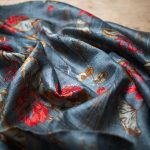Are you interested in sublimation printing but unsure which fabric to use? Choosing the right fabric is crucial to achieving high-quality prints that last. Sublimation printing is a process that uses heat and pressure to transfer dye onto fabric, creating vibrant and long-lasting designs. However, not all fabrics are suitable for this printing technique.
In this article, we will guide you through the process of choosing the best fabric for sublimation printing, so you can create stunning designs that stand the test of time. When it comes to sublimation printing, the fabric you choose plays a vital role in determining the quality of your final product. The fabric must be able to withstand the high temperatures and pressure used in the sublimation process without losing color or texture. Additionally, the fabric should have a high polyester content to ensure proper ink absorption and transfer.
With so many fabrics on the market, it can be overwhelming to choose the right one. But don’t worry, we’ve got you covered! In the following sections, we will discuss the factors to consider when choosing a fabric, the top fabrics for sublimation printing, and the benefits of using the best fabrics. So, let’s dive in!
Table of Contents
Understanding the Sublimation Printing Process
Let’s understand the sublimation printing process so we can choose the best fabric for our project.
Sublimation printing is a process where heat is used to transfer dye onto a fabric, resulting in a vibrant, long-lasting print. The dye is heated to a temperature that turns it into a gas, which then penetrates the fibers of the fabric. As the fabric cools, the dye re-solidifies, creating a permanent bond with the fabric.
To achieve the best results with sublimation printing, it’s important to select the right type of fabric. The fabric should be made of a high-quality synthetic material, such as polyester or a polyester blend. This is because the dye molecules need to be able to penetrate the fibers of the fabric in order to create a lasting print.
Natural fibers, such as cotton, do not work well with sublimation printing because they do not have the same ability to absorb the dye.
Another important factor to consider when selecting a fabric for sublimation printing is the weave of the fabric. The fabric should have a tight, smooth weave in order to ensure that the dye is evenly distributed and the print is crisp and clear. Fabrics with a looser weave may result in a print that is blurry or distorted.
By choosing the right fabric and ensuring that it has a tight, smooth weave, you can achieve professional-quality results with sublimation printing.
Factors to Consider When Choosing a Fabric
Choosing the right type of material is crucial for achieving vibrant and long-lasting prints, so it’s essential to consider factors like weight, texture, and stretchiness when making your fabric selection.
One of the most important factors to consider when choosing a fabric for sublimation printing is its polyester content. Polyester fabrics are ideal for sublimation printing because they have a polymer structure that allows the ink to bond with the fibers, resulting in a permanent and vibrant print. Look for fabrics that have a high polyester content, ideally 100%, for the best results.
Another factor to consider is the texture of the fabric. Smooth and flat fabrics like polyester, nylon, or spandex will produce the best results because they provide a consistent surface for the ink to transfer onto. Avoid using textured fabrics like cotton or wool, as they may result in a blurry or patchy print.
It’s also important to ensure that the fabric is free of any coatings, treatments, or finishes that may interfere with the sublimation process.
Top Fabrics for Sublimation Printing
When looking for materials to print on using sublimation, it’s important to consider polyester blends as they offer vivid and long-lasting results. Polyester is a synthetic material that allows the inks to be infused into the fabric, leading to bright and vibrant colors that won’t fade easily.
In addition, polyester blends are also durable and don’t wrinkle easily, making them perfect for custom apparel and other promotional items.
One of the most popular polyester blends for sublimation printing is 100% polyester. This fabric is lightweight, breathable, and moisture-wicking, making it ideal for athletic wear such as jerseys and workout clothes. It’s also a great option for custom t-shirts and other apparel items, as it drapes well and has a smooth surface that’s perfect for printing detailed designs.
Another great option for sublimation printing is polyester-cotton blends. These fabrics combine the benefits of polyester with the softness and breathability of cotton. They are also more affordable than 100% polyester fabrics, making them a popular choice for custom t-shirts and other promotional items.
Polyester-cotton blends are also easy to care for and can be machine washed and dried without shrinking or losing their shape.
Benefits of Using the Best Fabrics for Sublimation Printing
If you want your designs to stand out and last longer, you should consider using high-quality polyester blends for your sublimation printing projects. Here are some benefits of using the best fabrics for sublimation printing:
-
Vibrant Colors: Polyester blends are the best choice for sublimation printing because they absorb the dye better than other fabrics. This means that your designs will be more vibrant and eye-catching. The colors will also last longer without fading, even after multiple washes.
-
Durability: Polyester blends are known for their durability and resistance to wear and tear. They’re less likely to shrink, stretch, or wrinkle than other fabrics, which means that your designs will look great for a long time. Polyester blends are also resistant to stains and moisture, making them ideal for sports apparel and outdoor wear.
-
Cost-Effective: Polyester blends are a cost-effective option for sublimation printing because they’re easy to source and affordable. They’re also available in a wide range of colors and styles, so you can choose the perfect fabric for your project without breaking the bank. Plus, because they’re so durable, you won’t need to replace your designs as often, saving you even more money in the long run.
Using high-quality polyester blends for your sublimation printing projects is a smart choice. They offer vibrant colors, durability, and cost-effectiveness, making them the best option for creating long-lasting and eye-catching designs.
Fabrics to Avoid for Sublimation Printing
If you’re planning to do some sublimation printing, it’s important to know which fabrics to avoid.
First, natural fibers like cotton, silk, and wool are not suitable for sublimation printing because they don’t have the necessary polymer coating to absorb the ink.
Second, dark-colored fabrics should also be avoided because the sublimation ink won’t show up well on them.
So, stick to synthetic fabrics like polyester for the best results.
Natural Fibers
Natural fibers, like cotton and linen, aren’t ideal for sublimation because they tend to shrink and wrinkle. These materials are made up of cellulose fibers that don’t hold ink well. When sublimation ink transfers onto them, the fibers absorb the ink, causing colors to become muted and faded.
To avoid disappointing your customers, it’s best to stick with synthetic or synthetic-blend fabrics for sublimation printing. These materials are made from polymers designed to hold ink well, resulting in bright and vivid colors. Additionally, synthetic fabrics are more durable than natural fibers, which means that the final product will last longer and hold up better over time.
By choosing the right fabric for sublimation, you can ensure that your customers are satisfied with the final product, and they return to your business for future orders.
Dark Colors
When working with dark colors, it’s important to remember that sublimation printing may not produce the same level of vibrancy as it does with lighter shades. This is because the sublimation ink is translucent, and the darker the fabric, the more it will absorb the ink rather than reflect it. Therefore, it’s important to choose fabrics that are specifically designed for sublimation printing on dark colors, such as polyester or polyester blends.
Polyester fabrics are the most popular choice for sublimation printing on dark colors because they have a tight weave that allows for good ink penetration and transfer. Additionally, polyester fabrics are lightweight, breathable, and moisture-wicking, making them ideal for sportswear, activewear, and other performance-based garments.
Polyester blends, such as cotton-poly blends, can also be used for sublimation printing on dark colors, but they may not produce the same level of vibrancy as pure polyester fabrics. When choosing a fabric for sublimation printing on dark colors, it’s important to test the fabric first to see how it will react to the ink and to ensure that the final product meets your desired level of quality.
Preparing Fabrics for Sublimation Printing
To prepare your fabrics for sublimation printing, you need to follow three key steps:
-
Pre-treatment: Apply a special coating to the fabric to ensure the ink adheres properly.
-
Cleaning: Remove any dirt, dust, or oils that could affect the quality of the print.
-
Drying: Completely dry the fabric to prevent any water or moisture from interfering with the sublimation process.
By following these steps, you can ensure that your sublimation prints come out perfectly every time.
Pre-Treatment
Using a pre-treatment solution is essential for achieving vibrant colors and sharp images when sublimating onto fabric. Before printing, it’s important to apply a pre-treatment solution to the fabric to ensure that the ink adheres properly.
Here are two important things to keep in mind when using pre-treatment:
-
Use the right pre-treatment solution for your fabric. Different fabrics require different pre-treatments, so make sure you choose the right one for the fabric you’re using. Some pre-treatments are designed specifically for polyester fabrics, while others work better on cotton or blends.
-
Apply the pre-treatment evenly. It’s important to apply the pre-treatment evenly across the fabric to ensure that the ink adheres properly. If the pre-treatment is applied unevenly, you may end up with patches where the ink didn’t transfer properly. Use a sprayer or roller to apply the pre-treatment solution evenly across the fabric.
By following these two tips, you can ensure that your pre-treatment is applied correctly and that your sublimation prints turn out vibrant and sharp. Don’t skip this important step in the sublimation process!
Cleaning and Drying
Properly cleaning and drying your materials is crucial for achieving high-quality sublimation results. Before starting the cleaning process, make sure to remove any dirt, dust, or debris from the fabric surface. You can use a lint roller or a soft-bristled brush to gently remove any loose particles.
When it comes to washing the fabric, use a mild detergent and cold water to avoid damaging the material. Avoid using fabric softeners or bleach, as they can leave residues that may affect the sublimation process.
Once washed, hang the material to air dry or use a dryer on low heat. Make sure the fabric is completely dry before starting the sublimation process to prevent any watermarks or discoloration.
By taking these simple steps, you can ensure that your sublimation prints come out vibrant and long-lasting.
- Tetron Fabric for Marine Applications: Durability and Use Cases - June 18, 2025
- Tetron Fabric for Outdoor Furniture: Weather Resistance and Care - June 18, 2025
- Tetron Fabric for Wall Coverings: Style and Application Tips - June 18, 2025





